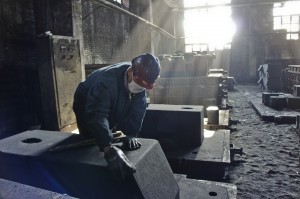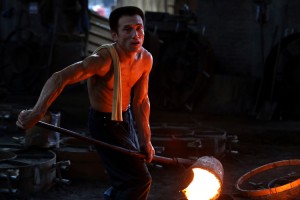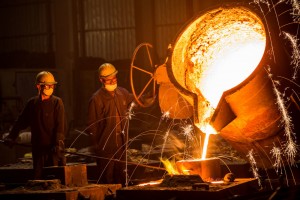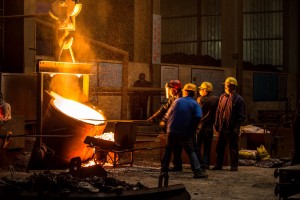Ductile iron is a high-strength cast iron material developed in the 1950s. Its comprehensive properties are close to that of steel. Based on its excellent properties, it has been successfully used to some castings with high performance requirements on stress, strength, toughness, and wear resistance. Ductile iron has rapidly developed into a cast iron material that is widely used after gray cast iron. The so-called “replace steel with iron” mainly refers to ductile iron.
Nodular cast iron is nodular graphite obtained through nodularization and inoculation treatment, which effectively improves the mechanical properties of cast iron, especially improves the plasticity and toughness, thereby obtaining higher strength than carbon steel.
China Ductile Iron Development History
Iron was unearthed from the iron smelting site in the middle and late Western Han Dynasty in Tieshenggou, Gongxian County, Henan Province, and modern nodular cast iron was not successfully developed abroad until 1947. The cast iron in ancient China has a low silicon content for a long period of time. That is to say, in the Western Han Dynasty about 2000 years ago, the spherical graphite in Chinese ironware was softened by low-silicon pig iron castings which is obtained by annealing. This is the ancient Chinese cast iron technology. The major achievements of art are also miracles in the history of metallurgy in the world.
In 1981, Chinese ductile iron experts used modern scientific methods to study the 513 ancient Han and Wei iron wares unearthed, and determined from a large number of data that nodular graphite cast iron appeared in China in the Han Dynasty. The related papers were read at the 18th World Conference on History of Science and Technology, which sensationalized the international foundry and the history of science and technology. International metallurgical history experts verified this in 1987: Ancient China had already found the rule of using ductile iron to make nodular cast iron, which is of great significance for the reclassification of world metallurgical history.
Composition
Cast iron is an iron-carbon alloy with a carbon content greater than 2.11%. It is obtained from industrial pig iron, scrap steel and other steel and its alloy materials through high-temperature melting and casting molding. In addition to Fe, the carbon contained in other cast iron is precipitated in the form of graphite. If the precipitated graphite is in the form of strips, the cast iron is called gray cast iron or gray cast iron;the cast iron in the form of worms is called vermicular graphite cast iron; the cast iron in the form of floc is called white cast iron or yard iron,;the cast iron Cast iron is called ductile iron.
The chemical composition of spheroidal graphite cast iron except iron is usually: carbon content 3.0~4.0%, silicon content 1.8~3.2%, manganese, phosphorus, sulfur total not more than 3.0% and proper amount of nodular elements such as rare earth and magnesium.

Main performance
Ductile iron castings have been used in almost all major industrial sectors, which require high strength, plasticity, toughness, wear resistance, and strict resistance.
Heavy thermal and mechanical shock, high temperature or low temperature resistance, corrosion resistance and dimensional stability. In order to meet these changes in service conditions, nodular cast iron has many grades, providing a wide range of mechanical and physical properties.
Most of the ductile iron castings as specified by the International Organization for Standardization ISO1083 are mainly produced in the unalloyed state. Obviously, this range includes high-strength grades with a tensile strength greater than 800 Newtons per square millimeter and an elongation of 2%. The other extreme is the high plastic grade, which has an elongation greater than 17% and a correspondingly low strength (minimum 370 N/mm2). Strength and elongation are not the only basis for designers to choose materials, and other decisive important properties include yield strength, elastic modulus, wear resistance and fatigue strength, hardness and impact performance. In addition, corrosion resistance and oxidation resistance as well as electromagnetic properties may be critical for designers. In order to meet these special uses, a group of austenite ductile irons, usually called Ni-Resis ductile irons, were developed. These austenitic ductile irons are mainly alloyed with nickel, chromium and manganese, and are listed in international standards.
Post time: Jun-03-2020



